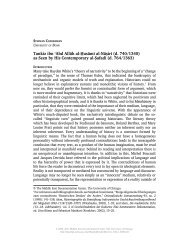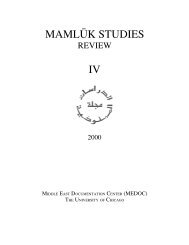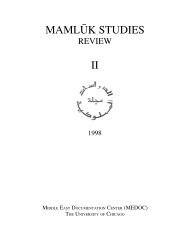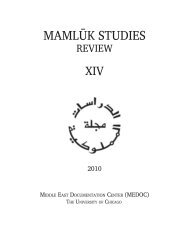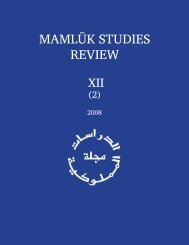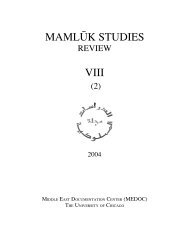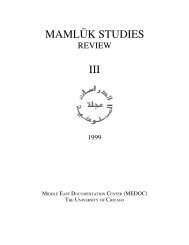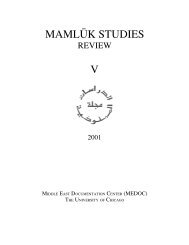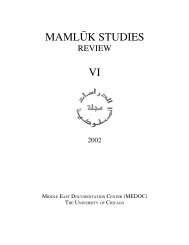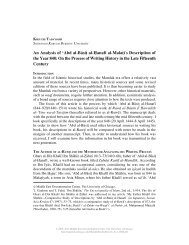Vol. VII, no. 1 (2003) - Mamluk Studies Review - University of Chicago
Vol. VII, no. 1 (2003) - Mamluk Studies Review - University of Chicago
Vol. VII, no. 1 (2003) - Mamluk Studies Review - University of Chicago
Create successful ePaper yourself
Turn your PDF publications into a flip-book with our unique Google optimized e-Paper software.
MAMLU±K STUDIES REVIEW VOL. 7, <strong>2003</strong> 17<br />
enlivened his chronicle <strong>of</strong> sixteenth-century Egyptian affairs with stories <strong>of</strong> a<br />
folkloric nature. As has already been <strong>no</strong>ted, some chroniclers used their histories<br />
as display books for examples <strong>of</strong> fine chancery prose. The Ba‘alabakk| chronicler<br />
Qutb al-D|n al-Yu≠n|n| (640–726/1242–1326) included a striking amount <strong>of</strong> poetry<br />
in what was formally an annals <strong>of</strong> Syrian history. In doing so, he was perhaps<br />
following the earlier example <strong>of</strong> Abu≠ Sha≠mah, the Syrian chronicler <strong>of</strong> Ayyubid<br />
times. (But al-Yu≠n|n|'s readiness to include satirical poetry and poetry which<br />
celebrated love and wine-drinking is curious given the chronicler's ascetic<br />
tendencies, his devotion to hadith studies and his admiration for the austere Ibn<br />
Taym|yah. 47 ) Muh˝ammad ibn Muh˝ammad Ibn S˛as˝ra≠'s late fourteenth-century<br />
chronicle <strong>of</strong> Damascus was peppered with fables, proverbs, and moralizing advice. 48<br />
Nevertheless, there were limits to the literarization <strong>of</strong> history writing, and most<br />
chronicles <strong>of</strong> the <strong>Mamluk</strong> period were rather uninterpretative, pedestrian chronicles<br />
<strong>of</strong> public affairs whose authors do <strong>no</strong>t seem to have dreamt <strong>of</strong> emulating such<br />
earlier stylish writers <strong>of</strong> history as al-Mas‘u≠d| or Miskawayh.<br />
Like the chronicle, the bestiary could also serve as a pretext for the kind <strong>of</strong><br />
erudition befitting an ad|b. For example the H˛aya≠t al-H˛ayawa≠n (Lives <strong>of</strong> beasts)<br />
by Kama≠l al-D|n Muh˝ammad ibn Mu≠sá al-Dam|r| (745–808/1344–1405) more<br />
closely resembles al-Ja≠h˝iz˝'s classic Kita≠b al-H˛ayawa≠n than it does a work <strong>of</strong><br />
scientific zoology, as al-Dam|r| repeatedly digressed into literature and folklore<br />
and, for some reason, he chose to add the caliphs to his collection <strong>of</strong> beasts.<br />
However, he was more systematic than al-Ja≠h˝iz˝ in that he dealt with his creatures<br />
in alphabetical order. Al-Dam|r|, who ended up as a faq|h in Cairo, had started <strong>of</strong>f<br />
as a tailor and his career, like that <strong>of</strong> al-Nawa≠j|, who also started as a tailor,<br />
indicates that the life <strong>of</strong> an alim was a career open to all the talents. 49 The earlier<br />
bestiary Kita≠b Mana≠fi‘ al-H˛ayawa≠n (Usefulness <strong>of</strong> beasts) <strong>of</strong> Ta≠j al-D|n ‘Al| Ibn<br />
Durrayhim (712–62/1312–66) is <strong>no</strong>t so very scientific either, but in Ibn Durrayhim's<br />
historischen <strong>Vol</strong>kskunde Ägyptens nach mamlukischen Quellen (Berlin, 1983), esp. 9–12, 127–30;<br />
Weintritt, Formen; Bernd Radtke, Weltgeschichte und Weltbeschreibung im mittelalterlichen Islam<br />
(Stuttgart, 1992); idem "Zur 'Literarisierten <strong>Vol</strong>kschronik' der <strong>Mamluk</strong>enzeit," Saeculum: Jahrbuch<br />
für Universalgeschichte 41 (1990): 44–52; Li Guo, "<strong>Mamluk</strong> Historiographic <strong>Studies</strong>: The State <strong>of</strong><br />
the Art," MSR 1 (1997): 33–37.<br />
47 Li Guo, Early <strong>Mamluk</strong> Syrian Historiography: Al-Yu≠n|n|'s Dhayl Mir’a≠t al-Zama≠n, 2 vols.<br />
(Leiden, 1998), 1, esp. 87–94.<br />
48 Muh˝ammad ibn Muh˝ammad Ibn S˛as˝ra≠, A Chronicle <strong>of</strong> Damascus, 1389–1397, ed. William M.<br />
Brinner, 2 vols. (Berkeley, 1963).<br />
49 József Somogyi, "Ad-Dam|r| H˛aya≠t al-H˛ayawa≠nja," in Semitic <strong>Studies</strong> in Memory <strong>of</strong> Immanuel<br />
Löw, ed. Alexander Scheiber (Budapest, 1947), 123–30; Manfred Ullmann, Die Natur- und<br />
Geheimwissenschaften im Islam (Leiden/Cologne, 1972), 39–40.<br />
© <strong>2003</strong>, 2012 Middle East Documentation Center, The <strong>University</strong> <strong>of</strong> <strong>Chicago</strong>.<br />
http://mamluk.uchicago.edu/<strong>Mamluk</strong><strong>Studies</strong><strong>Review</strong>_<strong>VII</strong>-1_<strong>2003</strong>.pdf



